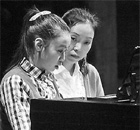Society
Shanghai shaping up to become water-saving society
By Liang Chao (chinadaily.com.cn)
Updated: 2010-04-15 16:12
 |
Large Medium Small |
"After filtering acid and alkali, the rainwater is contained to prevent secondary pollution to soil, and we water each vegetable 8 to 10 times per day with only 900 to 1,500 milliliters of the rainwater consumed each time," said Yao Yongkang, a manager of the zone.
"It meant we used 90,000 cubic meters of the purified rainwater a year for growing the high-quality vegetables for overseas markets with the same amount of irrigation water saved from other water supply sources," he said.
Shanghai was honored as one of the country's first batch of water-saving model cities in 2003.
Ever since, authorities have nailed down a plan that will run until 2020 to use every precious drop of water to quench the coastal metropolis' thirst and make a water-saving society to take shape by 2010 for its sustainability.
"We have made a set of local legal framework governing all aspects of water-saving alternatives for local users to adopt and law-enforcement agencies to inspect their effect by law," said Shen Weizhong, an official for SWSA.
According to the latest statistics unveiled by SWSA, up to 3,805 water-saving measures have been carried out throughout the city during 2003-09 through updating urban water supply pipeline networks, popularizing water-saving home appliances, particularly, flush toilets for old residential districts, using treated water for urban waterscapes and service sectors like car washing.
By 2009, the maximum quantity of water the city has saved per day has amounted to 471,700 cubic meters.
The local water authorities renovated more than 6,400 kilometers of outdated water supply pipeline to stop leaks with 97 small water plants shut down on the outskirts and replaced with a centralized water supply network.
In this way alone, the local water leakage rate in its suburban areas has been brought down to less than 20 percent or reduced by half compared with previous years.
To encourage local residents in old towns to give up using outdated flush toilets consuming 9 liters of water or more each flush, authorities have subsidized them to adopt water-saving toilets, with 220,000 sets of the new toilets installed for them, which helped to save more than 3.5 million cubic meters of water by the end of 2009.
In addition, water supply authorities have helped communities to have their old-style faucets replaced with ceramic valve ones to avoid causing water leakage in parks, urban lawns and public places
In universities and colleges, hotels and hospitals, more than 13,700 sets of IC card-based bath showers have been installed for users to develop a habit of taking short showers, which, experts say, can save about 500,000 cubic meters of water a year.
The city is now capable of saving more than 2.5 million cubic meters of water a year by carrying out about 100 water-saving technological transformation projects among its major industrial sectors to have their cooling water systems updated to use more recycled water.
By 2009, Shanghai consumed an average of 84 cubic meters of water to produce each 10,000 yuan ($1,464) of gross domestic product (GDP), the internationally recognized water thrift standard. That was down from 184 cubic meters in previous years and was below the national average.







